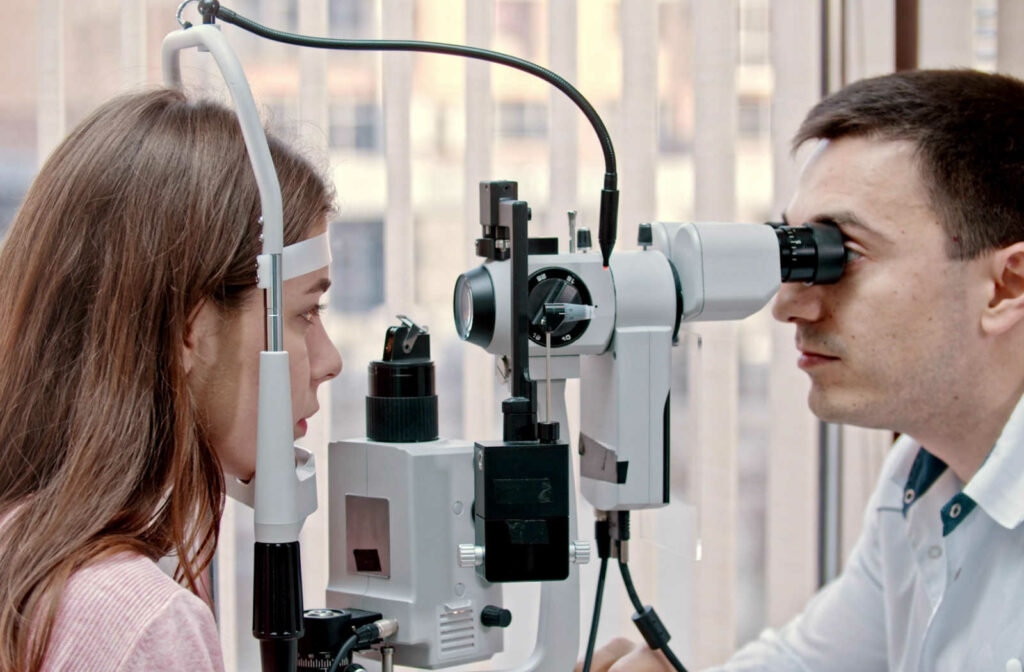When scheduling your annual eye exam, finding time in your calendar can be challenging, especially if you don’t know how long an eye exam can take. Do you have time to schedule it before your work meeting? How long will the kids be away from school? It’s important to know so you can balance your time effectively.
A complete eye exam can take 20 to 60 minutes, depending on several factors, including whether you have specific eye concerns or are getting a contact lens exam and fitting. For instance, if it’s as simple as a retinal imaging, it may only take about 20 minutes.
At Eyes on Plainville, our optometrists perform comprehensive exams, take time to answer questions and explain what we’re doing while still helping you get back to your day on schedule.
What Affects the Length of an Eye Exam?
Your eye exam will be personalized to your needs, so not all eye exams take the same amount of time. Typically, the length of your eye exam can depend on the following:
- Whether you’re a new patient
- If you’re getting a dilated eye exam
- Any new eye injuries, diseases, or family history information
- If you have specific symptoms or eye concerns to address
What Happens in an Eye Exam?
A comprehensive eye exam will include a series of tests to assess the health of your ocular structures and test your vision for any changes.
Refractive Error Test
Over 150 million Americans experience refractive errors, including:
- Myopia (nearsightedness)
- Hyperopia (farsightedness)
- Astigmatism
- Presbyopia
Refractive errors cause blurry vision, eye strain, headaches, and more symptoms that can be relieved with vision correction. Refractive error tests can determine your focus strength for your new eyeglass prescription and help produce sharper vision.
Visual Acuity Test
A visual acuity test uses the Snellen chart, one of the most recognized tools in an optometrist’s office. This test measures how well you can see words and details at a distance.
For children who can’t read quite yet, we use a chart full of shapes and images to make it easy and fun for your child to take their visual acuity test.
You’ll be asked to read the chart aloud using both eyes and again using one eye at a time. This test can help your optometrist determine if your visual acuity has changed since your last eye exam and if you need further vision correction.
Visual acuity tests measure in a fraction, at 20 feet distance. If you have 20/20 vision, it indicates you can see clearly at that distance, the same as others with normal vision could see. In contrast, if you have 20/40 vision, you can see clearly 20 feet away, as someone with normal vision could see from 40 feet away.
Retina Exam
A retina exam assesses the health of the retina, macula, and optic nerve at the back of the eye. Your optometrist will examine the blood vessels to determine if they look healthy or if you show signs of eye diseases like macular degeneration or diabetes.
Visual Field Test
Your visual field is the area you can see at its widest when looking at something ahead. Otherwise called a perimetry test, it refers to the peripheral vision out of the corners of your eyes. A visual field test can help identify blind spots in your vision, which can indicate certain eye disorders, such as glaucoma.

Silt Lamp Test
Using a low-powered microscope and a light, your optometrist can see a comprehensive picture of the ocular structures, including:
- Eyelids
- Conjunctiva
- Iris
- Lens
- Sclera
- Cornea
- Retina
- Optic nerve
Digital images of your eyes may be taken to monitor changes in the eye over time. A slit lamp test can be a valuable diagnostic tool in identifying eye conditions such as macular degeneration, cataracts, detached retina, abnormalities in the retinal blood vessels, or eye injuries.
Intraocular Pressure Test
Glaucoma is a group of eye disorders that can damage the optic nerve. It’s typically caused by increased pressure in your eye, referred to as intraocular pressure (IOP). Glaucoma doesn’t have very many early signs you can identify until the pressure buildup damages the optic nerve so severely that you experience some degree of permanent vision loss.
Tonometry measures IOP to determine if your pressure is within the normal range, but your optometrist can also employ additional tests for glaucoma in some instances, including:
- Optical coherence tomography (OCT), which can identify changes in the optic nerve
- Pachymetry, to measure corneal thickness
- Gonioscopy, to measure the angle where the iris and cornea meet
- Visual field test to determine if there’s vision loss in peripheral vision
Schedule Your Annual Eye Exam
Your eye exam is about more than your vision. It helps maintain the overall health of your eyes. Contact us to book your eye exam with our optometry team to keep your eyes healthy and vision clear.





